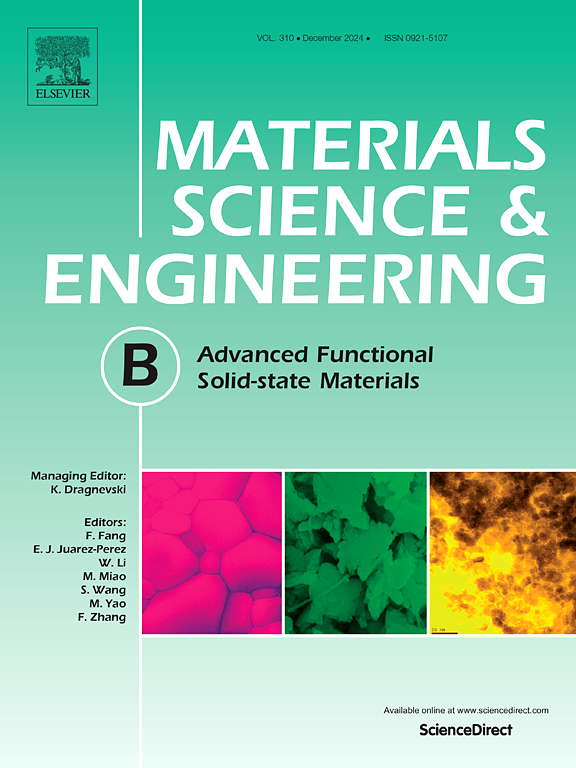一种吸附铅的Bi12CoO20/ZnO纳米复合材料的合成
IF 4.6
3区 材料科学
Q2 MATERIALS SCIENCE, MULTIDISCIPLINARY
引用次数: 0
摘要
本研究探索了Bi12CoO20/ZnO纳米复合材料作为高效吸附剂从水溶液中去除铅(II)的特殊潜力,重点介绍了其在废水处理中的创新应用。这些纳米复合材料结合了Bi12CoO20和ZnO的独特性能,为环境修复提供了一种很有前景的解决方案。采用热重分析、x射线衍射、扫描电子显微镜、能量色散x射线光谱、拉曼光谱、比表面积分析和pHPZC等表征技术,对Bi12CoO20、ZnO和Bi12CoO20/ZnO纳米材料的结构、形态和物理化学性质进行了全面的表征分析。通过参数研究评价了主要参数对铅(II)吸附过程的影响。对实验结果进行了仔细分析,评价了铅的吸附动力学,并采用双参数模型确定了吸附等温线。在pH为7、0.25 g L-1、初始浓度为50 mg L-1、35℃、平衡时间为30 min的条件下,收率达到99%,最大吸附量为204.081 mg g -1。拟二级动力学模型是描述Pb(II)吸附实验数据的最合适模型,表明Pb2+离子的去除过程与化学吸附有关,在浓度为50 mg L-1时,速率常数为1.2732 × 10-3 g mg−1 min−1。而Temkin平衡等温线模型更适合于拟合实验数据和解释吸附过程。此外,利用Bi12CoO20/ZnO纳米复合材料在太阳照射下对两种有机污染物(碱性蓝41和日落黄)进行了光催化降解实验,证实了其双重功能,结果令人满意。这些发现证明了纳米复合材料在吸附和光催化方面的潜力,标志着它们是先进的、可持续的水净化技术的有希望的候选者。本文章由计算机程序翻译,如有差异,请以英文原文为准。
Synthesis of an original Bi12CoO20/ZnO nanocomposites for lead adsorption
This study explores the exceptional potential of Bi12CoO20/ZnO nanocomposites as highly efficient adsorbents for the removal of Lead (II) from aqueous solutions, highlighting their innovative application in wastewater treatment. These nanocomposites combine the unique properties of Bi12CoO20 and ZnO, offering a promising solution for environmental remediation. A comprehensive analysis has been performed on the characterization of the nanomaterials Bi12CoO20, ZnO, and Bi12CoO20/ZnO, where the structural, morphological, and physicochemical properties were examined using various characterization techniques, including thermo-gravimetric analysis, X-ray diffraction, scanning electron microscopy, energy-dispersive X-ray spectroscopy, Raman Spectroscopy, Brunauer-Emmett-Teller analysis for specific surface area and pHPZC. A parametric study was carried out to evaluate the impact of the main parameters on the lead (II) adsorption process. The experimental results obtained were carefully analyzed to evaluate the kinetics of lead adsorption and to determine the adsorption isotherms by applying two-parameter models. A 99 % yield was achieved at pH 7, 0.25 g L-1, 50 mg L-1 initial concentration, 35 °C and an equilibration time of just 30 min, with a maximum adsorption capacity of 204.081 mg g−1. The pseudo-second-order kinetic model is the most suitable model for describing the experimental data related to the adsorption of Pb(II), indicating that the removal process of Pb2+ ions is associated with chemical adsorption, with the rate constant determined to be 1.2732 × 10-3 g mg−1 min−1 at a concentration of 50 mg L-1. While Temkin’s equilibrium isotherm model proved more appropriate to fit the experimental data and explain the adsorption process. Additionally, photocatalytic degradation experiments under solar irradiation of two organic pollutants (Basic Blue 41 and Sunset Yellow) were conducted using the Bi12CoO20/ZnO nanocomposite to confirm its dual functionality, and the results were satisfactory. These findings demonstrate the nanocomposites’ potential for both adsorption and photocatalysis, marking them as promising candidates for advanced, sustainable water purification technologies.
求助全文
通过发布文献求助,成功后即可免费获取论文全文。
去求助
来源期刊

Materials Science and Engineering: B
工程技术-材料科学:综合
CiteScore
5.60
自引率
2.80%
发文量
481
审稿时长
3.5 months
期刊介绍:
The journal provides an international medium for the publication of theoretical and experimental studies and reviews related to the electronic, electrochemical, ionic, magnetic, optical, and biosensing properties of solid state materials in bulk, thin film and particulate forms. Papers dealing with synthesis, processing, characterization, structure, physical properties and computational aspects of nano-crystalline, crystalline, amorphous and glassy forms of ceramics, semiconductors, layered insertion compounds, low-dimensional compounds and systems, fast-ion conductors, polymers and dielectrics are viewed as suitable for publication. Articles focused on nano-structured aspects of these advanced solid-state materials will also be considered suitable.
 求助内容:
求助内容: 应助结果提醒方式:
应助结果提醒方式:


